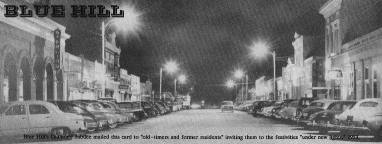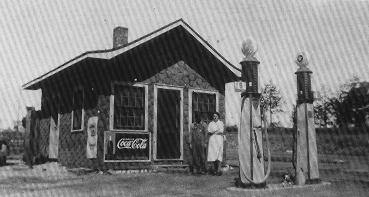Blue Hill -- Webster CountySettlement began in this area during the 1870s. A town site was laid out one mile south of the Adams-Webster county line, on the Hastings branch of the Burlington & Missouri River Railroad in 1878. The immediate expansion of the town can be attributed to the good soil, the fine railroad facilities, and its distance from larger towns. These same conditions still exist, with both a north-south and east-west line of the Burlington-Northern Railroad still in service here. The town was first called Belmont, but since there was already a town by that name, the people chose the name "Blue Hill." Gannett's work on place names states that the town was so named because of a "bluish atmosphere" surrounding the hill the town was built on. The population, according to the census bureau, has ranged from 138 hearty souls in 1880 to 883 equally-hearty souls in 1980. In the 1970 census the bureau had the population listed at 1,200, however, this included the entire precinct, not just the city. After several letters to the bureau, the record was corrected to 760 people. The first building in Blue Hill was a hotel owned by Albert Blumenthal. A post office was built with John A. Wetmore as postmaster. Hall and Wetmore then established an agricultural implement business. By 1882 there were three banks and a full array of shops and businesses including a photographer, two physicians, and a newspaper. The town still has a livestock sale barn, feed store, and drinking establishments (now referred to as lounges), as well as present-day services that include cablevision, a medical center, a greenhouse, and specialty businesses such as cake baking and crafts. The community has many descendents from the first settlers of the Blue Hill area. On June 24, 1890, a fire nearly destroyed the north side of the business block. The firemen fought valiantly to contain the fire with bucket brigades from the two cisterns available. After the fire, citizens insisted that the town build a water tower for more adequate fire protection. In 1890-91, a 100,000-gallon water tower was built. It still serves as Blue Hill's water system. Almost as soon as the town began, a non-denominational church was built. Congregations in the early 1900s included German Lutheran, Catholic, Methodist, Christian, Presbyterian, Evangelical, and Independent Order of Good Templars. The congregations at the present time are Methodist, Catholic, American Lutheran, and Missouri Synod Lutheran. Schools started as soon as suitable housing was available, which usually was someone's kitchen. The first school district was formed in 1880. Early that spring a schoolhouse was built on land donated for that purpose. The class of 1892 appears to be the first high school class to graduate. The three-story brick schoolhouse, now the elementary school, was built in 1922-23. A junior-senior high school was built in 1963 following reorganization of the district. The people of Blue Hill voted to bring electricity into town in August 1910. Shortly thereafter a steam plant was built, along with the distribution lines. It served the town for many years. The light plant's two diesel-powered engines are still available as back-up power in an emergency, but the primary source of power comes from the Western Area Power Administration and Nebraska Municipal Power Pool. A swimming pool was built in the northeast part of town in 1932 by local businessman George Corner, and donated to the village in 1937. In 1980 the city purchased the pool that was originally built for the Ash Hollow Country Club. The city had leased it for several years. The Glenwood Telephone Company originated in 1901, and built lines in the village the next year. This small company still serves Blue Hill and eight other communities in the immediate area. Activities in Blue Hill have centered around the school gym, city hall, and the community room at Westgate Manor (low rent housing units). Recently the people in the community have worked together at a variety of fund raising activities that include "The $100 Club," hometown revue, bake sales, and soup suppers, to match 25 percent of the $200,000 block grant needed to build a community-senior center. This has been a very worthwhile effort, with the project now fully funded. By Ann Hartman, Box 277, Blue Hill, NE 68930 |
 Blue Hill's Diamond Jubilee
Anniversary invitation to old-timers and former
residents to come home for the festivities
"under new lights." 1953.
 Typical farm house, when the
soddy or dugout had served its purpose. [Martin,
Bartley]
 George Corner's station, run
by Lewis Lukas and his wife. [Roskilly]
 With and without irrigation.
These fields of corn show a stark contrast and
hope for farming in Nebraska with the addition
of "ditch water." 1939. [Nebraska State
Historical Society]
|